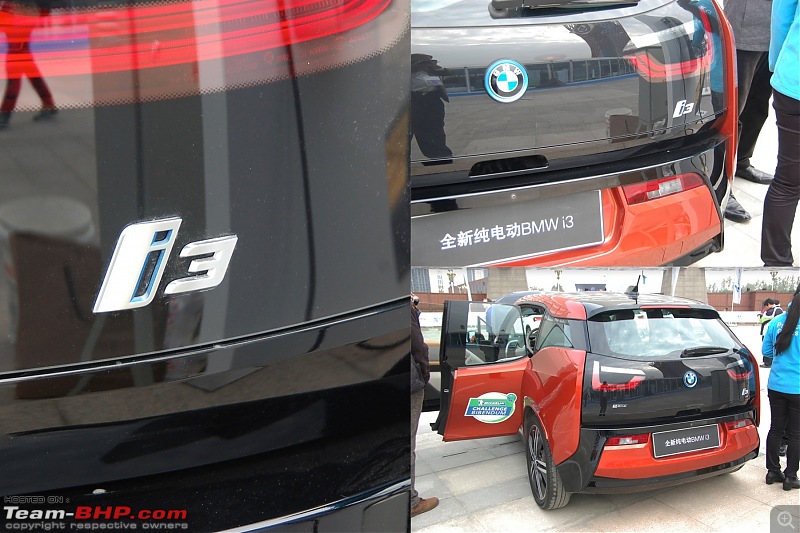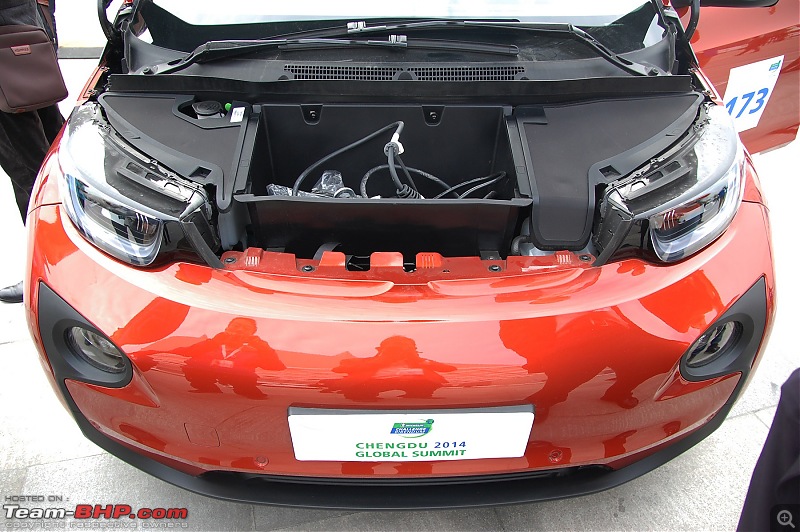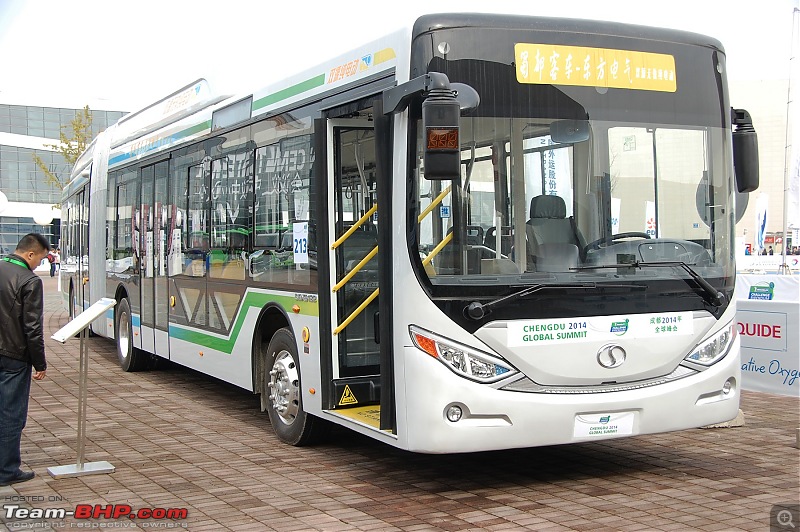Team-BHP
(
https://www.team-bhp.com/forum/)
The Michelin Challenge Bibendum presents probable solutions suggested by experts from industry & academia about clean, safe, connected and affordable mobility. Some of the solutions presented are out of the box, a result of years of R&D and application in different parts of the world. Some are evolutionary, meant to provoke thought, taking into account lessons learnt from previous research & application efforts. The speakers and audience at the Bibendum are the who-is-who of the political and industrial worlds.
The Michelin Challenge Bibendum is held quasi-periodically (see list below). It is an excellent platform to build stronger bilateral ties in the Transportation sector between France and the host country, and to bring in more collaborators from around the world into the discussion. Hopefully India will host the Bibendum in the near future, as India is a significant entity as a supplier & consumer.
Previous Bibendum Global Summits were held in
- Clermont-Ferrand, France in 1998, 2000
- Fontana, US in 2001
- Heidelberg, Germany in 2002
- Sonoma, US in 2003
- Shanghai, China in 2004 and 2007
- Kyoto, Japan in 2005
- Paris, France in 2006
- Rio, Brazil in 2010
- Berlin, Germany in 2011
The Challenge brings together everyone who has an interest in the Transportation sector. Users with ideas and suggestions, manufacturers with researched solutions, suppliers, public and private operators, universities, energy suppliers, research institutes, political leaders and NGOs. The Bibendum is now perhaps the only initiative in the world that brings together all stakeholders in the Transportation sector under one roof - to discuss and develop a common vision for sustainable transportation, and to deliberate & decide upon actual solutions that generate individual, business and social benefits.
Participation in the 2014 Global Summit at Chengdu, China was a wonderful opportunity to bring to BHPians information about the technical advancements & innovations that were presented by the different participants, especially in the area of Electric and Hybrid vehicles. The visit was completely sponsored by Michelin, who brought more than 400 journalists to the Summit this year.
Before we get into the technical aspects of the Bibendum Challenge, let us look at the general aspects of the conference. The organization was, in one word, SUPERB! The scale of thinking was gigantic. The facilities - AWESOME! The first thought one got at the venue was the scale that the organizers had handled. The Conference Center housed the exhibition by different companies from the automotive sector, as also consulting organizations showing their work in the transportation sector. It housed different rooms where the breakout sessions & discussions took place.

The venue had activities spread out over a large area:
- The Conference Center
- The Convention Center and the grounds
- Tracks where we could drive the vehicles


The stalls at the Bibendum convention were at par with anything that one would expect internationally. You could see the skill of a few commercial artists who were working everyday on a changing tableaux presenting different ideas.
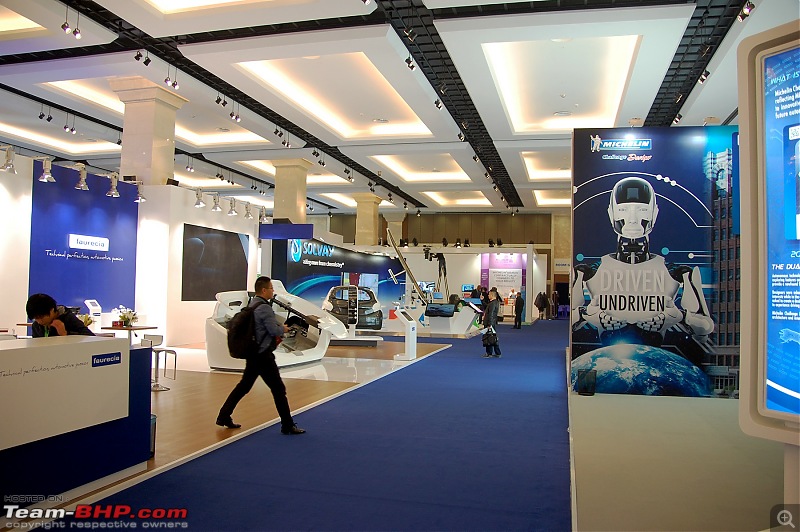


Almost all companies involved in research, product development and manufacturing (in the transportation sector) presented ideas, processes and products.
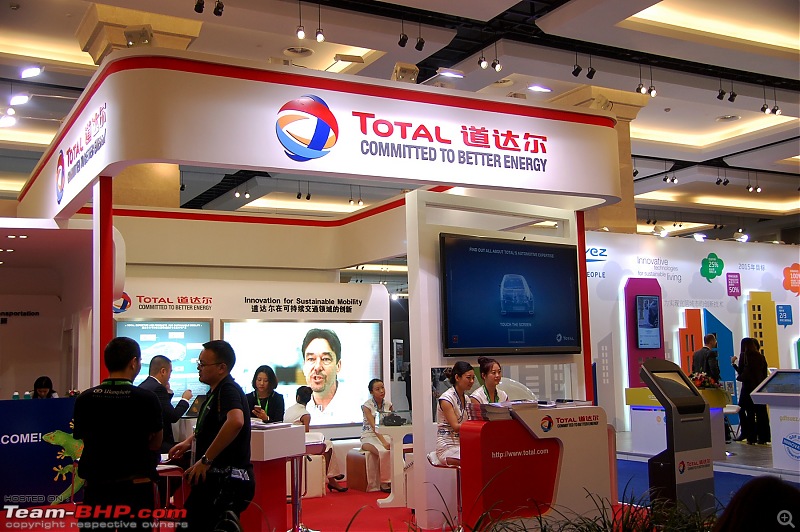

A few small Chinese product companies had stalls, but were not allowed to sell their products (one wished they did!!). Careland, shown here, makes Dashcams and Navigation systems.

One-wheelers? Yes, ONE-wheelers. Even we were dumbstruck to see off-the-shelf availability of battery-powered self-balancing one-wheelers. Does need a lot of skill, and a total lack of fear of learning a new technique, to ride these one-wheelers. Youngsters found it easy to adapt to, albeit shakily; oldies definitely found it as something that would need a week's effort to ride, despite the thick belt one can use as a 'handle'. But once one gets the hang of it, it is as intuitive as walking around with hands in pockets. One young demonstrator even did an impromptu waltz!!!


There were a few Segway clones, some even without handles. These were pretty straightforward to ride. Step on (a bit wobbly at the start if you haven't ridden one), straighten yourself, relaaaaax - and 'think' of moving in the direction you want to go. Relaxing is the mantra, since it is easy to make these wobble and oscillate if one tries to overcompensate with the knees or hands (on the version with handles). Speed is limited by firmware, so even if one leans 'too far forward', it won't really try to emulate a cheetah, nor would one clumsily fall on his face.
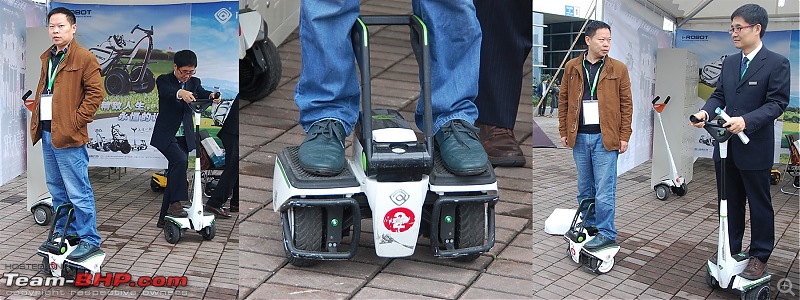
2-wheelers in all shapes and sizes - cycles and 'scooters'. The only thing one needs to visualize is where to mount the battery pack. The motor is always in the rear wheel hub and provides a surprisingly high level of assist. One has to remember that, with this category of vehicles, the motor provides assist only - starting has to be via muscle power. And it does save a lot of effort with the assist it provides.

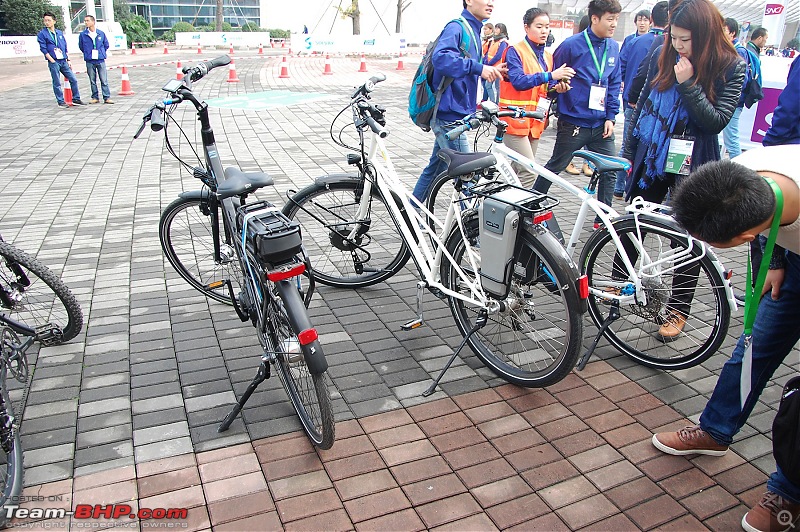
You can easily fall in love with the Bud-e, a foldable 'scooter'. It even has a tiny side stand! Bud-e has a thumb-operated throttle, pretty effective braking and pulls like a dog (OK, a small one). Easy to become a child once again - step on it, push a couple of times with the other leg, depress the throttle - and wheeeeee - away we go!!! Once done, you can fold it and - holding by the handle - roll it away.

Here come the real scooters. From dinky little single-seaters to conventional step-throughs, these do not require a duck-waddle to launch themselves. Much higher power than the previous category. Colourful as they come, streets in China are full of these.

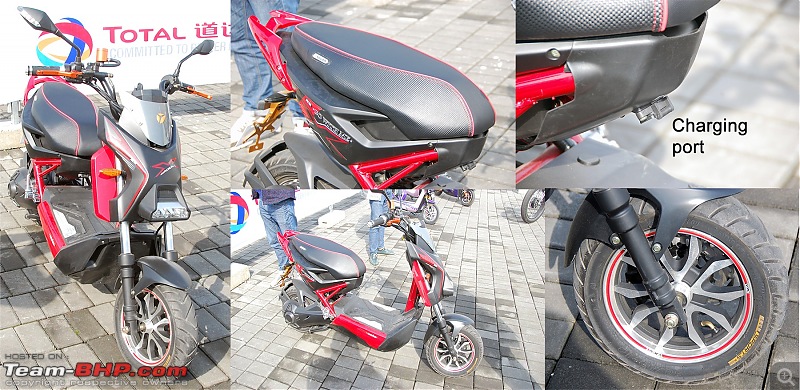

"Oy, stop your yakkity-yak and give way". Here comes the boss - the BMW electric scooter. The BMW C evolution scooter is the zero-emissions counterpart to BMW Motorrad / Motorcycle's C600 Sport & C650 GT and "marks the start of a new chapter in urban mobility". The main body of the bike houses an 8 kWh lithium-ion battery and has a powerful motor, with a continuous output of 11 kW, peak output of 35 kW (47 PS) and 7.3 kg-m of torque, it's good for 0-50 km/h in 2.7 seconds. Range tops 100 km, depending on what mode it’s in and how it’s ridden. Energy recuperation is automatic, and flat battery to full charge takes just 3 hours. Top speed is 120 km/h!

Electric-assisted 3-wheeled delivery vehicles, anyone? There were a couple of engineering companies who had very innovative commercial 3-wheelers on show.




BYD Auto is the biggest Chinese car maker, which also has a 50:50 joint venture with Daimler AG. Sells luxury electric cars under the Denza brand.

The Qin plug-in hybrid with a range of 70 km in full electric mode.

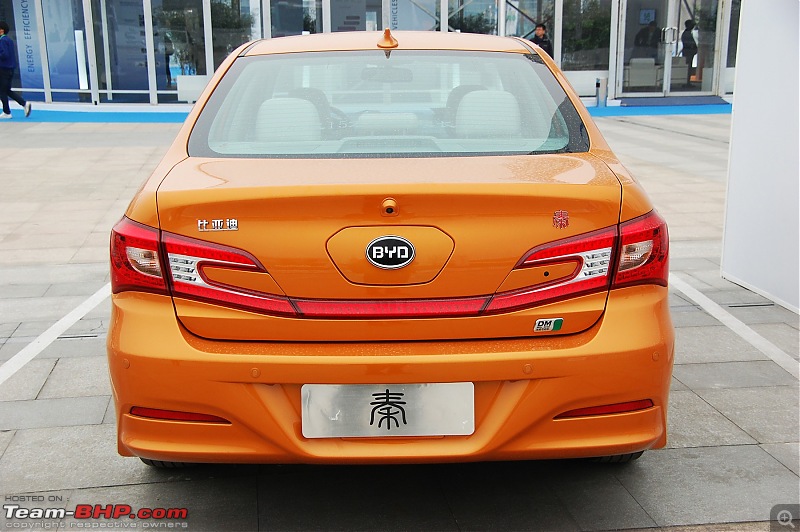
Denza's first car, an electric sedan. Max speed of 150 kms & range of 300 kms.



Well, this one is not a Chinese Chinese car, it is a Chinese offering from CitroŽn.

The DS 6 comes with a 163 PS or 200 PS petrol engine, coupled with an automatic 6-speed transmission. The DS 6 is manufactured at the CAPSA plant in Shenzhen. It is expected to reach the European market sometime in 2015-16. With a length of 4.70 m, DS 6 WR (Wild Ruby) is a "Plug-in (Full) Hybrid Electric Vehicle" (PHEV) that has evolved from the HYbrid4 diesel-electric, rechargeable from a power outlet.
Strictly speaking, the DS 6 is an uncharacteristic offering from CitroŽn.


The ride is comfort-oriented, and there is no noticeable body roll. The turbo-petrol is peppy and spirited.

Over 4 days (between Nov 11th and 14th, 2014), the MCB Hackathon was the busiest area: coding, coding, coding! 75 participants in 14 teams coded non-stop, taking only a few refreshment breaks. Mentors from the industry (including one from WIPRO) helped the teams in taking on the coding challenge.

The themes set for the Hackathon, based on Sustainable Mobility, were:
* CO2 reduction
* Low-emission & high-safety urban zones
* Door-to-door solutions
* Last-mile Freight delivery
* Mobilization of private investment
In the words of the organizers, the participant categories were:
----------------------------
IDEA GENERATOR: You have a cool app idea about sustainable mobility and you want to build a prototype out of it.
DEVELOPER: You’re ready to dive into two-day of coding to create an innovative app. Vote on the ideas you want to work on and let the coding begin.
DESIGNER: Flex your creative muscle and bring your team's app to life with an awesome user experience.
SUPER POWER: You've got crazy marketing, presenting and networking like skills, and you want to use them to clinch a win for your team.
----------------------------
Judgement criteria sounded simple, but in implementation were anything but:
1. Completion: Deliver a simple, complete user experience without any bug
2. UI/UX: Develop an understandable and user-friendly user interface with a good navigability
3. Innovation: Propose a new concept and/or target new domains in at least one game changer field
4. Business Model: The project must respond to a real need with significant market potentials

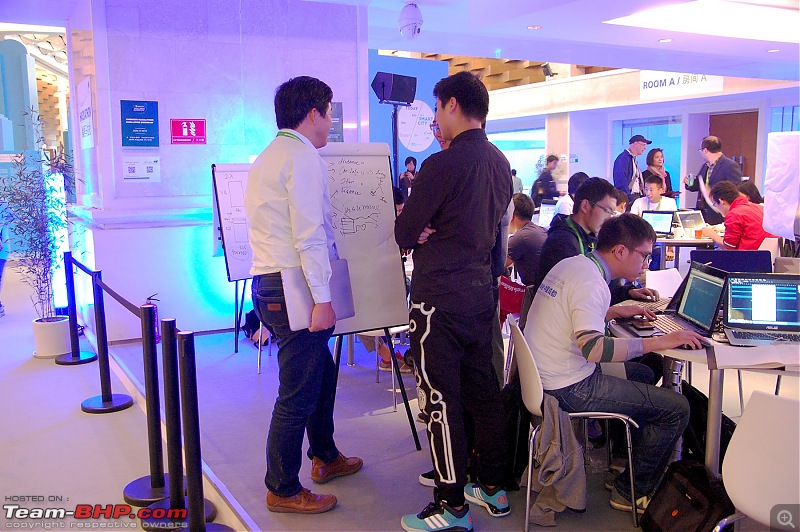
The teams presented a variety of 1-minute ideas on the first afternoon, ranging from LBS for personal safety, bicycle riding to gain coupons to carpooling based on university campus.
The teams and their projects were:
- Blue Crystal team for Yoja;
- Bubble & Zing team for Ecycle;
- Coding rapidly team for FLEXI;
- Cut ji team for Green Run;
- Hercules team for Hercules carpooling;
- JDoIt team for battery recharge locations;
- Nahan team for Biking;
- Outman team for Watcher;
- Panda team for personal safety guardian;
- Sciencentic team for campus carpooling;
- Travel green team for mobility related environmental footprint index;
- wipGENIX team for Cloud Location;
- Canda team for Pocket Bus;
- Easy 4S team for car sharing during 4S maintenance
Michelin launched its new "puncture-proof" Selfseal tyre in the conference – allowing us to drive it over vicious three-inch spikes. Honestly, puncture and change-to-spare experiences are so terribly ingrained in our minds that most of us baulked & braked at the last moment, maybe because our primitive brains rebelled. Are you sure everything will be fine??? "Yeah, go ahead and drive normally over them!" Okaaaay!?!?!




Though thoroughly holed, the tyre continued safely at speed, with no adverse effects. It did lose a couple of psi, yet nothing out of the ordinary. This tyre will go on sale in 2015.
Selfseal uses a patented rubber-based compound housed inside the tyre, which immediately and permanently plugs any holes in the tread. Michelin anticipates the greatest take-up in "certain south and south-east Asian countries" where drivers experience a puncture, on average, every 1,700 km, compared with every 120,000 km in Europe. Should sound familiar in many cities in India, no?
We were also part of a very illuminating session over lunch with Michelin CTO Terry Gettys. He knows tyre technology like the back of his hand. A few excerpts:
* The composition of rubber used in tyres is the biggest challenge for any tyre company
* Tyre maker's biggest headache is the significant price variation of natural rubber, which varies from $ 1-6. Synthetic rubber price variation is less at $ 2-3
* The current thrust of research is for Synthetic Elastomers from bio-renewable sources, not petroleum
* World mobility is expected to double in the next 20-30 years
* Robustness of tyres is top priority for Michelin
* Improvement to radial tyres will continue for the next 10 years
* Beyond 10 years, Tweels will be gradually replacing rims and tyres
* Michelin is developing Tweels for 3-wheelers (read autorickshaws) first
* Michelin Solutions provides truck tyres where one pays for km driven, not tyre. This is becoming popular with trucking companies in Europe
* Apparently US truckers prefer their tyres to be good-looking, rather than caring much about performance
* In Thailand, commercial pick-up truck tyres wear out in 6 weeks on an average. Michelin's innovations for PU truck tyres extended life to 4 months, enabling Michelin to capture significant market share
* India: For the near future, Michelin will concentrate on tyres for commercial and public transport. One reason for this is the large commonality of passenger car tyres with other markets such as Brazil and South Africa, which is prompting international car makers to demand the same tyres for India as well
This one is about putting in a little and gaining a lot. Reminds one of the Hindi proverb "Hing lage na phitkari, rang bhi chowkho aaye" (literally: No need for asafoetida or potash alum to get colour)!



The Poclain hydraulic transmission offers greater mobility to small cars and LCVs on difficult ground conditions (mud, snow, sand, steep slope…). The hydraulic assistance principle of the AddiDrive Assist system consists of the installation of hydraulic motors in the rear axle trees of the FWD vehicle. This is a real alternative to classical transmission systems. It does not add any significant extra weight, nor mechanical loss - all the while enabling an increase in the vehicle's mobility on demand and a decrease in fuel consumption. The AddiDrive system is ESP-compatible, and is active continuously whatever the speed of the vehicle.

 The heart of the system: the MF hydraulic wheel motor in the axle
The heart of the system: the MF hydraulic wheel motor in the axle
Poclain-Hydraulics says:
This motor provides high torque directly to the wheel. In difficult road conditions, the driver can rely on the assistance of the hydrostatic transmission on top of the mechanical transmission up to 28 kmph. At road speed, the hydraulic motors are freewheeled automatically. The system preserves full efficiency because it doesn't generate additional losses. 

In an alternate configuration where it is difficult to mount the hydraulic wheel motor at the ends of the axle (for example, where there is no real axle), Poclain also has a single Hydraulic Central Motor mounted in the center of the vehicle between the wheels. This can drive the wheels with drive axles on either side of the unit.
 Operating principle:
Operating principle:
Two MF hydraulic motors are directly integrated onto the spindle of either a steering axle or a fixed axle. They are connected by a pump at the output of the gearbox power take-off (PTO) and a hydraulic valve. The MF hydraulic becomes active when desired. On demand (controlled by a switch on the dashboard even when the vehicle is moving), these motors instantaneously transform a 2WD into a 4WD, thus ensuring a much greater traction efficiency.

(pic courtesy Poclain)
When the vehicle is in on-road mode or free wheeling mode, pistons in the interior of the motors are separated from a cam ring. If the conditions of the road are adverse or there is loss of traction, the Hydraulic Assistance mode is engaged by the driver via the dash switch. Once the 4x4 system is engaged, the vehicle gains traction by sending power to the hydraulic motors. This feature only works in low travel speed. When the conditions improve, the system disengages automatically.
Benefits:
This system guarantees the trajectory of the vehicle during descents and thus its safety, thanks to the hydraulic assistance' restraining capacity. Compared to a permanent mechanical all-wheel drive, AddiDrive Assist saves weight, lowers the CG and shortens the turning radius. There is no need to raise the vehicle's chassis, preserving easy access to the cab and easy loading. The hydraulic motors are free-wheeled on the highway: no losses!
The essential mechanical system in this was first put on trailers as Trailer Hydraulic Assist (circa 1970). In 2005, the system was made available for trucks. In 2014 it has been made available for LCVs and buses. The new system for cars has been presented in 2014. Peugeot has been a long time partner of Poclain. Peugeot has been using the system (they call it MTC - Mechanical Traction Control) in their LCVs. The new AddiDrive Assist system has been adapted for the Peugeot 207, 208 and 2008.
Currently the clients actively adapting some of their vehicles to the AddiDrive Assist systems are Peugeot, Citroen, Dacia, Renault, Nissan, Fiat and Mitsubishi.
Retrofitting, though theoretically possible, is not a trivial task. The critical task is incorporating the hydraulic pump at a PTO point on the transmission.
On plans for India, the Poclain representative at the stall said "A European car maker is starting the cycle in January 2015, for release probably in 2016." He obviously couldn't name the manufacturer, so let the guessing games begin (your guess is as good as mine ;))!!!
The Porsche Panamera S E-Hybrid. This is a plug-in hybrid. 416 horses, 590 Nm torque, 0 - 100 in 5.5 seconds and top whack of 270 km/h! Does nearly 12 kpl in the city.
In full-electricity mode, it has a range of 36 kms and top whack of 135 kph.

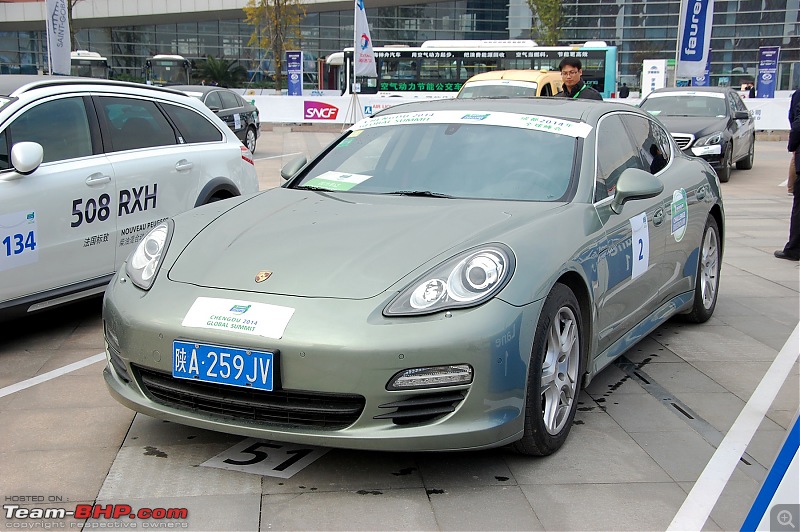





Renault had, by far, the widest range of cars on display.
Twizy:

The Twizy is an insanely fun vehicle to drive - a cross between a motorcycle and a car. The only unnerving part, initially, is finding a steering wheel instead of a handlebar in the front - the seating is tandem, so the expectations of a bike don't go away... till one starts driving. Wheeeeeeee! The battery can be charged with an extendable spiral cable stored beneath a flap at the front of the vehicle.
ZOE EV:
 Kangoo Z.E.
Kangoo Z.E.:
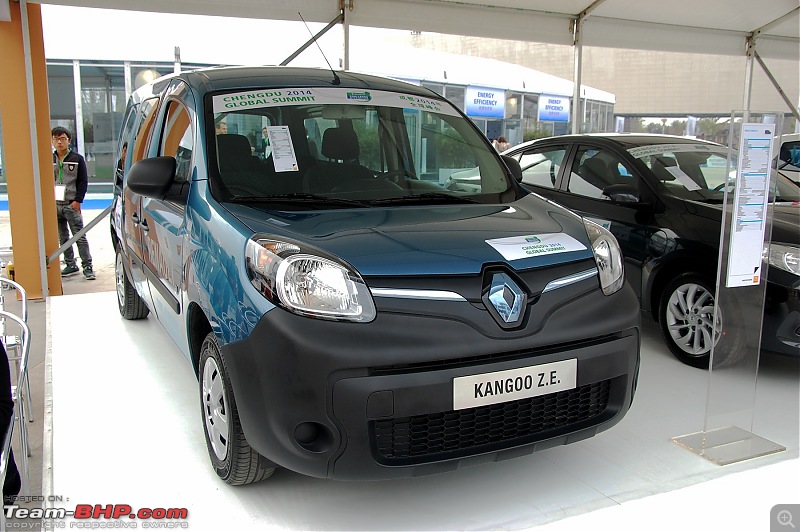 Fluence Z.E.
Fluence Z.E.:

Tesla Model S. 'Nuff said!
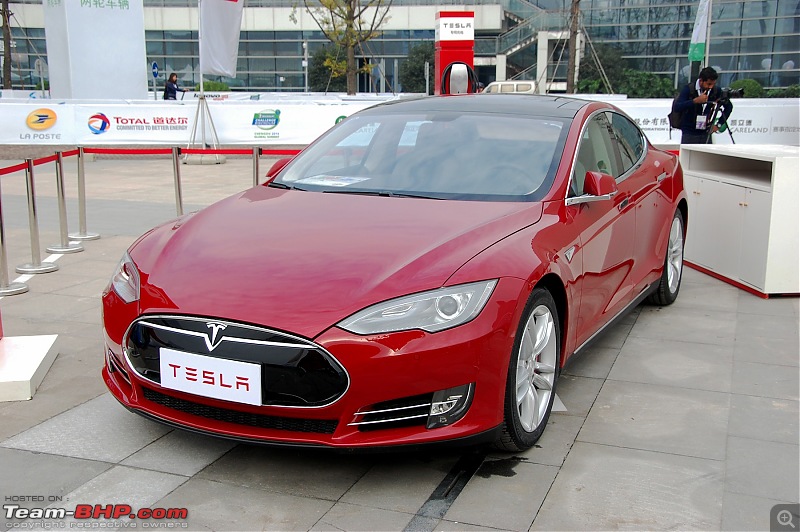


It is enough to stand back and appreciate, salivate, wonder.
Three days of intense discussions, tech demonstrations and drives came to an end with a glittering closing ceremony replete with song and dance, and (to be expected) speeches. Fortunately, the speeches were short, sweet and succinct - with promises to accelerate the improvements to transportation and mobility for the good of everyone, in any country.

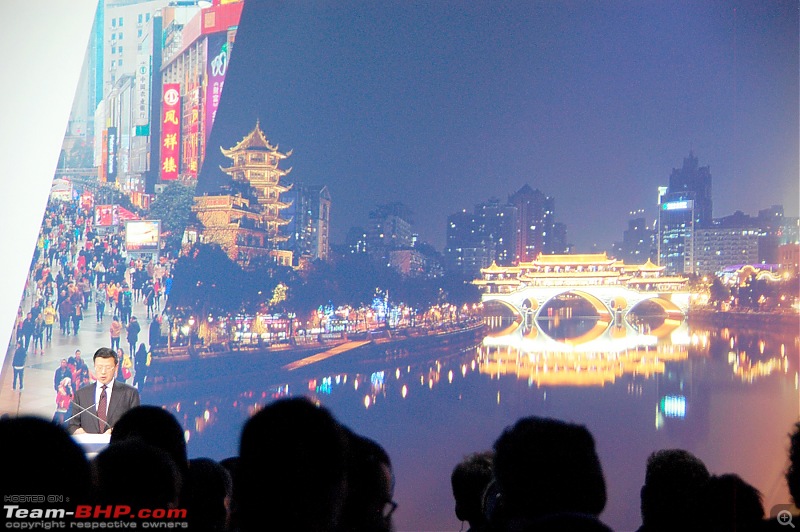
China manages to impress everyone with its sense of urgency, purpose, scale and ability to do things that matter the most. China, the new China outside of the cramped inner city environs, is spanking new and growing. Everything is massive, a pointer to the imagination being put to good use with enormous support from the Govt. Distances are large - we commuted 40 km one way each day, in less than an hour.
The surprise on the first day was the police escort provided to the convoy of buses ferrying media persons from the respective hotels to our conference venue. Apparently, the bus timings were the same as the peak traffic time (7-8 AM, 4-7 PM) and traffic jams take 60-90 mins to clear! Left to our own bearings, we would have had to start at 5 AM to reach the venue. Some media persons felt the chaos first hand on one of the return journeys - their trip took 150 minutes on the same route!



On the face of it, Chengdu looked like any modern city in, say, the US. But that's where an apparently developing country is different from a developed country. Traditions are still apparent amongst all the modernity.

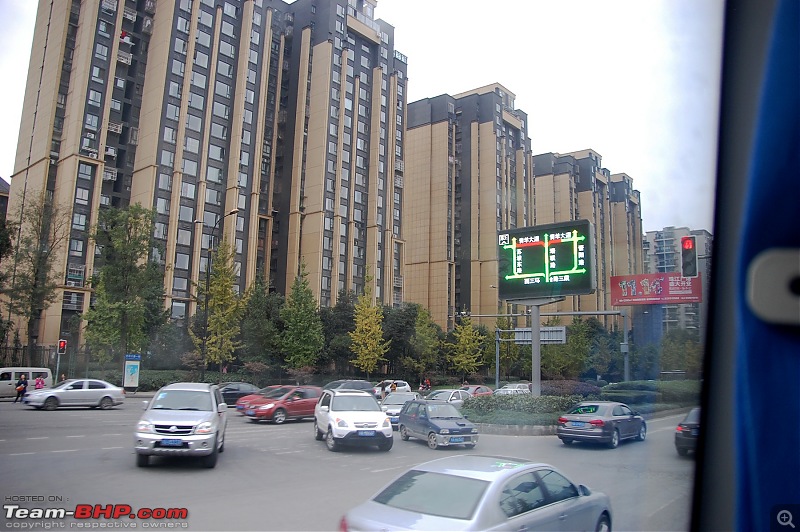

Everything seems calm and organized, the people disciplined and following rules...till the next traffic lights!!!
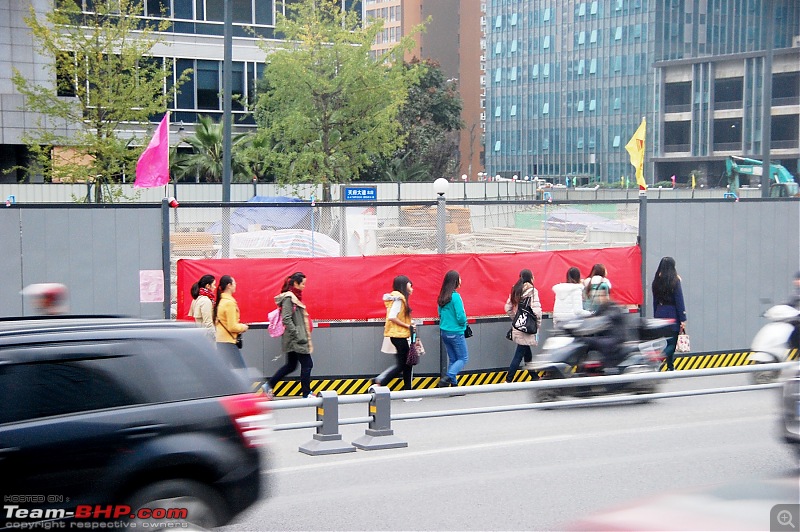


There is enough quaint quirkiness to be seen here. From the unconventional:
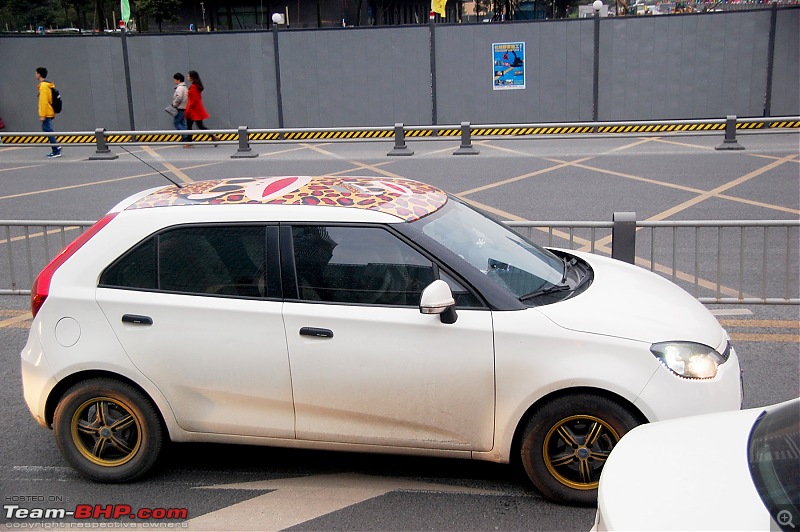
To the mix of traditional and swank:

The scale at which China is constructing its infrastructure is to be seen to be believed. This is supposedly the world's largest building, or perhaps the world's biggest shopping mall. The New Century Global Center.
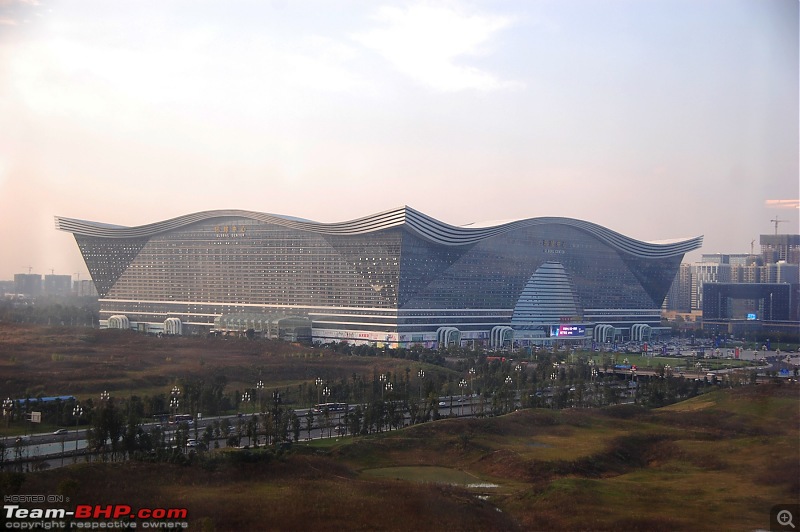

The contrasts are sometimes stark. Here a lady is emptying the trashcan of empty water bottles, which she will probably sell for recycling.

OTOH, our hotel had a Christmas theme - in November!
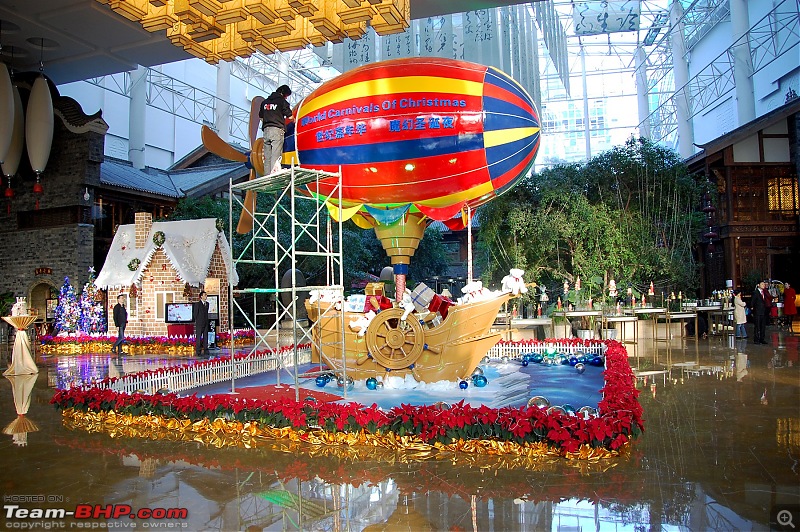
In almost all parts of the world, business is conducted in the center of the city, and people live on the outskirts. Well, in Chengdu, it is the other way round. Apparently, the high tech industry has come up near the outskirts of the city - and people live in affordable mass housings near the center of the city. This causes traffic to flow out of the city in the morning, and towards the city center in the evening. And high density traffic it is - 4 parallel lanes on the Tianfu Avenue, each way! Chengdu has 3 elevated ring roads to relieve the traffic and shorten travel times.




Nothing is left to chance, nothing is left uncontrolled, nothing is un-cared for. What more can one ask of governance and administration? Even the trees are coaxed to grow vertically, as opposed to going every which way that they have a natural tendency to.

This is a set of statues in the city center - in a vehicle-free pedestrian zone! This is no different from some places in Japan or Europe. Did anyone complain? Or selfishly take advantage when no one was looking? Nope.

This is the waterfront along the Jinjiang River that flows through Chengdu. The water front, on the western side of the river, is lined with nice small restaurants.

The Verandah Bridge



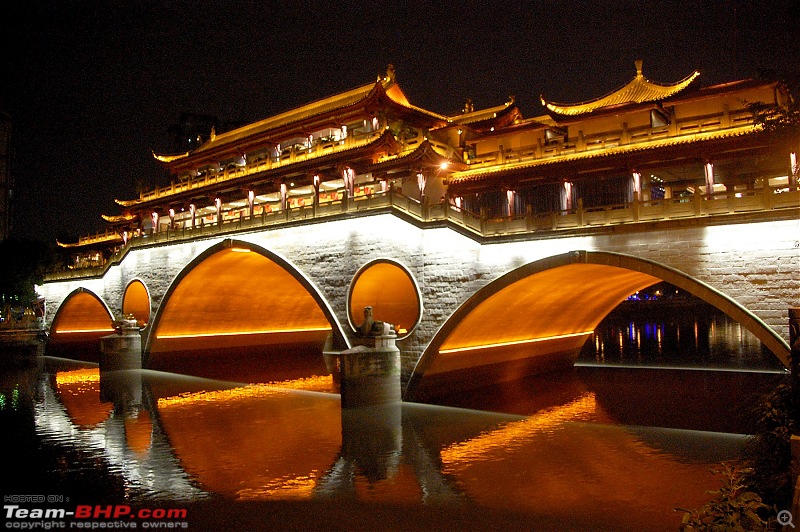
Pandas are the leit motif of Chengdu, as the largest population of Giant Pandas are to be found in the mountains that ring Chengdu in Sichuan.
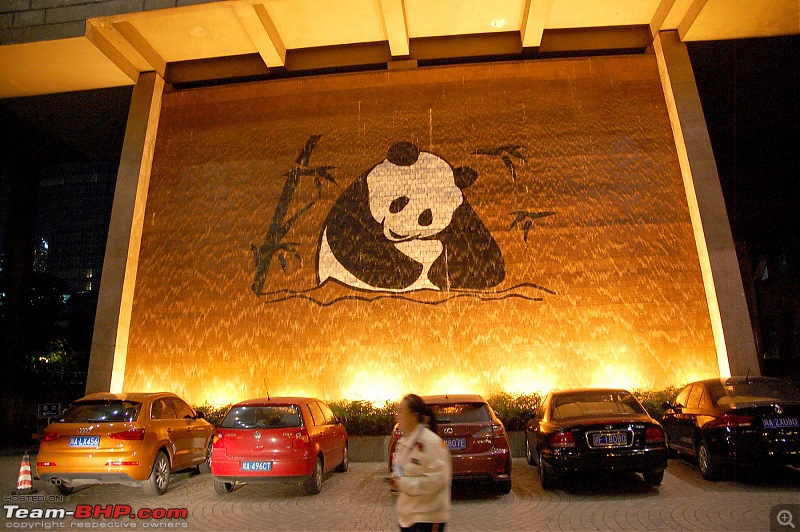
On the outskirts of Chengdu is the
Chengdu Research Base of Giant Panda Breeding, or simply
Chengdu Panda Base. Its stated goal is to "be a world-class research facility, conservation education center, and international educational tourism destination." We visited the Chengdu Panda Base to look at Pandas, and believe you me, all of us were transformed into small children!



Though there are plenty of bamboo jungles around Chengdu, the pandas are not given those bamboos to eat. To feed them, Chengdu Panda Base transports a special variety of thin bamboo from the mountains nearby.



Pandas epitomize the German expression "Locker zu sein" which means, roughly translated, "to be cool and detached" or "hang loose". And hang loose they do, on the ground and in the trees - without a care in the world.


No one mutilates the street signs with posters.

And many areas make you wonder whether you are in what is the conception of China popularized in Kung Fu movies. Look closely - it presents an "almost there" comparison with anywhere in Europe or US.

One gets a feeling that the only things that are common between India and China are these:


Thanks for the details. It felt like peeping into the future. It's good that we're taking emissions seriously; but how safe are these batteries that we're going to use? Are they recyclable?
Looks like the traffic ensured you get a feeling of "at home" away from home ;)
| All times are GMT +5.5. The time now is 03:35. | |

























